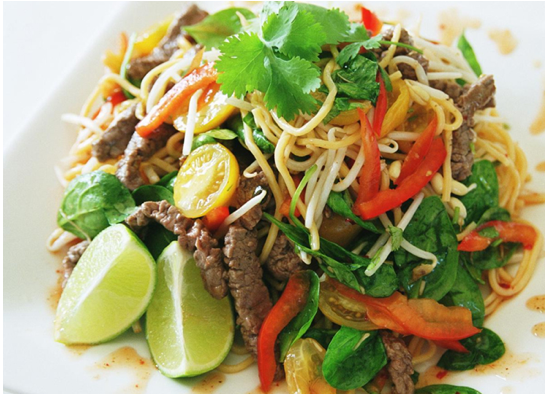
Fried foods are also in abundance on a Thai restaurant menu so you should steer clear of these.
Top tips what to eat and what to avoid at a Thai restaurant.
- If you’re a fan of spring rolls, try summer rolls instead. They are basically the same as spring rolls – vegetables and rice noodles enveloped in rice paper, but they are steamed instead of fried meaning that you get all the flavour of the vegetables and flavourings but without the fat. Satay chicken, game or tofu is also an excellent choice for a starter – the protein itself is very low in fat and full of flavour, and although the sauce/marinade contains peanuts, they are rich in heart-healthy fats making them a healthy choice.
- Tom yum soup is another good choice for a starter, not only because the chicken or shrimp in the soup is low in calories and fat, as is the broth of the soup, but also because a recent study in some of Japan’s top universities showed that tom yum goong is 100 times more effective at inhibiting the growth of cancerous tumours than other foods. Coconut soup, however, is something to steer clear of – although it’s full of flavour and heat, the coconut milk puts its calories on a par with any other cream-based soup, around 400 per serving, so unless you’re only going to eat this soup and nothing else it’s probably best to choose something else.
- One of the major bonuses of Thai food is that it is often full of chilli – and chilli is known to kick-start your metabolism as well as to flatten your blood sugar level after a meal, meaning that you won’t get a spike in your blood sugar levels, preventing food cravings later on in the day. Eat as much hot curry as you like, but steer clear of curries flavoured or thickened with coconut milk to save on fat and calories. Opt for boiled or steamed rice or noodles with your curry to fill you up and try asking for brown rice to keep you fuller for longer. Coconut rice, although tasty, is something to steer clear of as it’s full of fat and sugar – plus the calories you save on rice means that you could maybe treat yourself to dessert!
- One dish to definitely steer clear of is pla muok tad – it may sound like a tasty, authentic Thai dish, but it is basically deep-fried calamari and often totals more than 800 calories per serving. Instead, opt for steamed or pan-fried fish.
- Massaman curry, although full of flavour is often thickened with coconut cream. Sometimes though, it will simply be thickened with crushed potatoes and therefore will be without the fat from the coconut cream. Just ask the restaurant how the curry is made before you order – and if it is does contain coconut cream, simply ask for country-style gaeng pah instead, a hot and spicy water-based curry.
- Although you’ll often find sweet tea served in Japanese restaurants as a means of cooling down your mouth after eating the food, it is full of sugar. Ask for skim milk and you’ll save on calories but you’ll also counteract the heat of the food.
For more tips on Italian, Chinese, Japanese and other takeaway food click here
